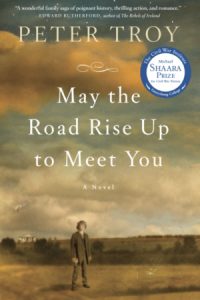The Story Behind the Book
The Story Behind MAY THE ROAD RISE UP TO MEET YOU by Peter Troy

It is impossible to say when this novel first began to germinate, but it surely dates back to at least 1985, when I graduated high school and spent the summer in the countryside beyond the suburbs of Dublin. I participated in a volunteer work camp at a settlement for Travelers, something akin to “gypsies” in Ireland. This was Ireland on the precipice of the economic boom it now enjoys, but the Travelers were a window back in time, terribly poor, forced by the government to settle in four-room, cinder-block houses in the shadow of the thirty-foot wall of a maximum security prison. It was hardly the lovely, lilting countryside I’d seen in The Quiet Man, and Maureen O’Hara, standing at the door of a thatched cottage, waving and smiling, her auburn hair drifting in the breeze wafting over the emerald-coated hills, was nowhere to be seen.
These people were oppressively poor. Their children wore clothes and shoes that were either far too big or too small for them, or were practically torn to shreds. They played on a great pile of refuse from the prison, a few old stoves and refrigerators set atop a small mountain of discarded wooden pallets, nails exposed everywhere. And yet it was through these families that I first came to know Ireland, a land filled with people quick to laugh, or stand against injustice, or celebrate the small wonders of life, and quick to love…though not to talk about it or show it through much affection. Even the youngest of the children were as tough as their environs, and above all, resilient.
More than twenty years later, echoes of that experience helped to create Ethan McOwen, and to endow him with all those same qualities. It was natural to place him in the darkest era in Ireland’s history, years my own ancestors endured, and to bring him to America on one of the little known Coffin Ships of the day. He would arrive in New York long before Ellis Island, a New York booming with extremes of prosperity and poverty, and as diverse a city as there was anywhere in the world. To pass from the horrific slums of the Five Points to the bastions of power and wealth in City Hall and Wall Street, required a walk of just a few blocks. And though the Five Points slum is no longer there today, and so much of the city has been torn down and rebuilt several times over, the echoes are still there to be heard, since New York never has been about buildings as much as it has been about people and experiences.
In my years as a student and teacher of history, no era interested me as much as the American Civil War. Shelby Foote’s epic account of the war served as pleasure reading, and over the ensuing years, I visited nearly every major battlefield east of the Mississippi River, mostly with my father, who had instilled his love of history in me at a very early age. Ethan would be a baseball player, like me (in college) and my father (invited to try out for the Yankees), and his father (who played in the minor leagues), and his grandfather (who played for the New York Giants in the 1880’s and 90’s).
I could never attempt to tell a story about the Civil War era without taking on the issue of slavery. Attending college in Washington, D.C., then living and working there for several years afterwards, I gained greater understanding of the African-American perspective of this nation and its history. Later, when I taught for four years in East Flatbush Brooklyn at a school more than ninety percent first or second-generation Haitian-American, my education continued. By this time I had learned a great deal about my own heritage and the struggles endured by my ancestors. It was not difficult to draw a ready comparison to the challenges my students and their families faced. I remember telling them that they could be whatever they wanted to be, and when one extremely gifted student interjected, “Anything but President,” I had nothing but idealistic platitudes to offer in response. That was more than ten years ago. And his voice still echoes in my ear, even in this brand new reality.
And finally, I knew that Ethan’s experience would be contrasted and complimented by Marcella. She would be highly intelligent, creative, and ambitious, all characteristics not particularly appreciated in women even today, but especially not in the nineteenth century. I had a perfect model for such a person in my mother. The oldest of six children raised on a civil-servant’s income, she was offered a full scholarship to college, only to be told by her mother that they needed her to go to work and assist in raising her five siblings. Her two brothers, she was told, would be the ones to go to college. But they barely made it out of high school, and my mother was forced to defer that dream. Then, after my three older siblings had already begun college, she and my father went back to school themselves, and graduated while I was entering my junior year. She was forty-seven when she finally fulfilled her lifelong dream of becoming a teacher, and she still teaches full-time today, having just turned seventy. Marcella, Mary, and so many of the women in this story would be the echoes of her strength and endurance and vision.
In the end, this is a book centered on the possible, and generated amidst my own dreams of twenty years ago, when the One-B of teaching seemed like an acceptable substitute for the One-A that was writing. It is a reclamation project, a bold, belated dream no longer deferred. And testament to the aspirations of those who came before me.
The echoes.

